
| What is Flavor and Fortune? |
| How do I subscribe? |
| How do I get past issues? |
| How do I advertise? |
| How do I contact the editor? |
Read 7002949 times
Connect me to:
| Home |
| Articles |
| Book reviews |
| Letters to the Editor |
| Newmans News and Notes |
| Recipes |
| Restaurant reviews |
| Article Index (all years, slow) |
| List of Article Years |
| Article Index (2024) |
| Article Index (last 2 years) |
| Things others say |
| Related Links |
| Log In... |
| Authors |
| Categories & Topics |
Soups: Sweet, Savory, and Super
| by Jacqueline M. Newman |
Soups and Congees
Winter Volume: 2012 Issue: 19(4) page(s): 25 - 27, and 36
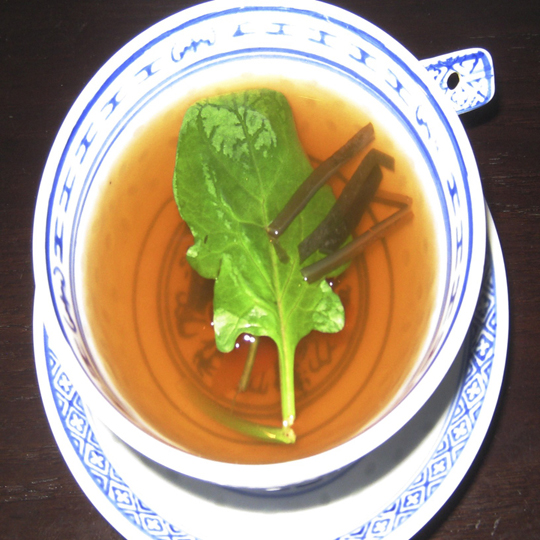
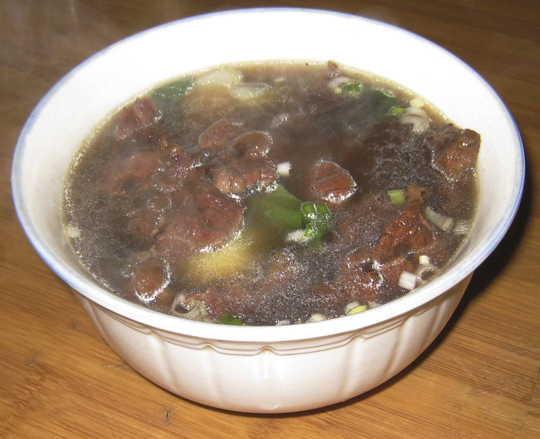 Known the world over, soups are comfort foods. In China, every congee, keng, soup, or stew is such a comfort food. The differences between soup and stew is only the amount of liquid within. One can become one or the other is just by adding or decreasing the amount of liquid making or serving it. Any one can also be sweet or savory, simply change the seasonings. All of them can be super with minced or mixed ingredients. These can be prepared beforehand or at the last minute, the extra or deleted liquid or ingredients proportioned at will. Use what is at hand, eat the results any time day or night, even during the night should you then get hunger or thirst-demanding pangs.
Known the world over, soups are comfort foods. In China, every congee, keng, soup, or stew is such a comfort food. The differences between soup and stew is only the amount of liquid within. One can become one or the other is just by adding or decreasing the amount of liquid making or serving it. Any one can also be sweet or savory, simply change the seasonings. All of them can be super with minced or mixed ingredients. These can be prepared beforehand or at the last minute, the extra or deleted liquid or ingredients proportioned at will. Use what is at hand, eat the results any time day or night, even during the night should you then get hunger or thirst-demanding pangs.
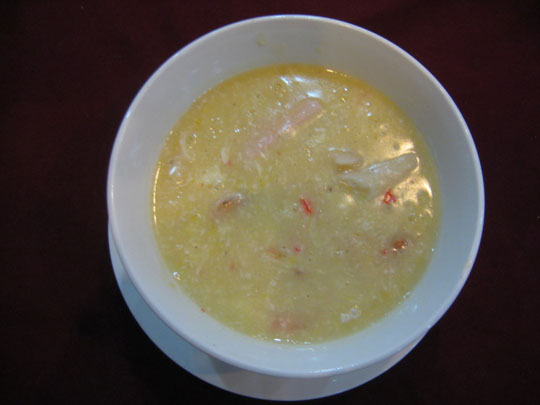 Years ago, soup eateries often had a calabash hanging above their front door. That was the clue as to their main dish. Diners could know this, their most often served item. During the Sung Dynasty (960 - 1279 CE), heavy soups were common. They were long on ingredients, short on liquids, and most often loved by their consumers. Fat or skinny, male or female, most people could not resist a good soup. In those days, they did not worry about the number of calories or commodities within. Today, thinner soups are more common and more cared about.
Years ago, soup eateries often had a calabash hanging above their front door. That was the clue as to their main dish. Diners could know this, their most often served item. During the Sung Dynasty (960 - 1279 CE), heavy soups were common. They were long on ingredients, short on liquids, and most often loved by their consumers. Fat or skinny, male or female, most people could not resist a good soup. In those days, they did not worry about the number of calories or commodities within. Today, thinner soups are more common and more cared about.
What magic is in a bowl of soup that makes it so loved? Is it nourishment or nutrition? Does it warm everyone's heart? Soups do invigorate eaters whether cooked quickly or prepared over longer periods of time. Almost all soups are good for folks of all ages; they seem to know that.
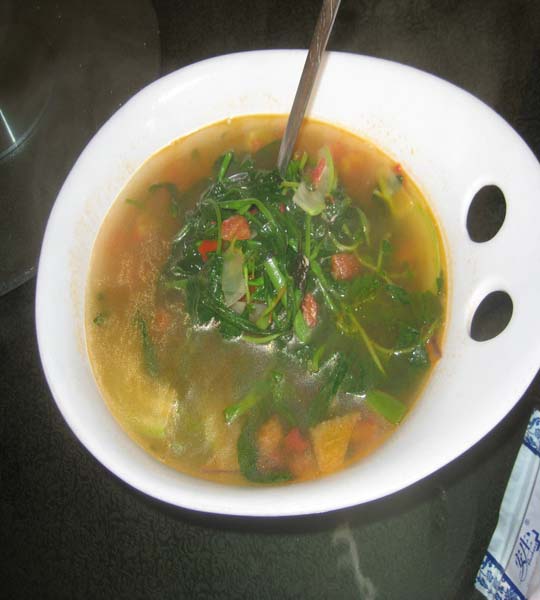 Change, that is to add or subtract one or more ingredients does not seem to change one's love for a bowl of a soup. Make it aromatic, dull, refreshing, tasty, or bland; load it with texture or offer it smooth as the skin on a baby's bottom, and there are a plethora of folk who will enjoy it.
Change, that is to add or subtract one or more ingredients does not seem to change one's love for a bowl of a soup. Make it aromatic, dull, refreshing, tasty, or bland; load it with texture or offer it smooth as the skin on a baby's bottom, and there are a plethora of folk who will enjoy it.
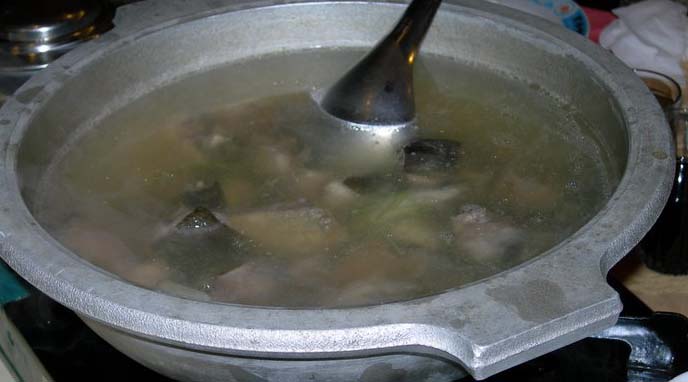
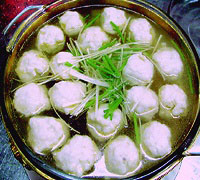 Most do not know that the Mongol word for soup is an honorific and revealed in Louis Ligeti’s volume Histoire Secrete des Mongols, Monumenta Linguae Monglicae Collecta I. There, another revelation is that soups can be consumed as a drink rather than eaten with a utensil. That volume tells even more about this course in a meal and when it should be served. The western world eats soup as the first or second course, and before the main course. Not so most Chinese; they prefer their soup at meal's end. They say it is 'to fill the cracks.'
Most do not know that the Mongol word for soup is an honorific and revealed in Louis Ligeti’s volume Histoire Secrete des Mongols, Monumenta Linguae Monglicae Collecta I. There, another revelation is that soups can be consumed as a drink rather than eaten with a utensil. That volume tells even more about this course in a meal and when it should be served. The western world eats soup as the first or second course, and before the main course. Not so most Chinese; they prefer their soup at meal's end. They say it is 'to fill the cracks.'
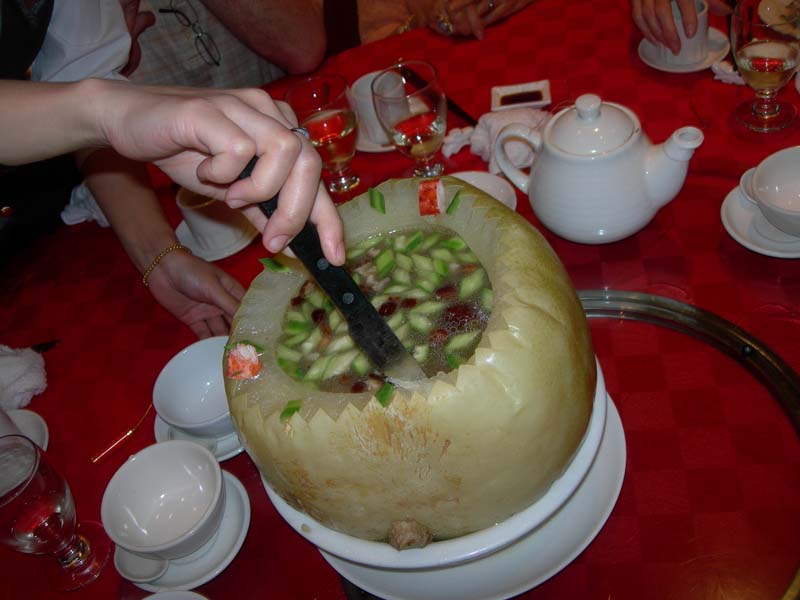 When Mongolians say they are or will 'eat the Khan's food,' they mean they are accepting his or another's special position. For them, soups are made with sheep, goat, camel, cattle, or sarlag, a cross between a cow and a yak. With no meat, to them, it is not a soup. Soups share warmth, and when sitting together and eating one, they show each other they care for and about each other.
When Mongolians say they are or will 'eat the Khan's food,' they mean they are accepting his or another's special position. For them, soups are made with sheep, goat, camel, cattle, or sarlag, a cross between a cow and a yak. With no meat, to them, it is not a soup. Soups share warmth, and when sitting together and eating one, they show each other they care for and about each other.
As indicated, Mongol's make their soups with one or more of the above meats and add vegetables, berries, other fruits, fungi, and still more plant foods along with spices, starches such as cereals, and much more. In the past, Mongolians were known to stand around and drink these foods. If the broth in them is boiled and thick, they appreciate them as the 'essence of their souls.'
There are many ways other Chinese eat and appreciate soups. The Fujianese adore many at a single meal. They also enjoy soups as snacks and they eat soups more often than at just one at one meal in a day. They like meat and fish in their soups, and meat inside their fish balls floating inside them. The Sichuanese are said to have originated hot and sour in their soups. Tea houses in their province actually serve more soups than they serve tea. In nearby provinces they serve soups mixing one or more fruits along with pork or spare ribs, either on the bone.
Chinese children get their Vitamin C from the soups their mom or grandma makes for them at breakfast, not from having a morning glass of OJ. For them, soup is also a popular snack when returning from school. Pregnant women have soup often and call the one their mothers make for them 'mothers brew.' They get it often before and after they give birth. While hoping for a son in China's one-child world, this brew has lots of ginger, vinegar, and pigs feet, and lots of calcium, and it is cooked for many an hour. The lots of calcium is something every new mother in China wants and needs; it comes from vinegar eating away at the bones that are a must in this brew.
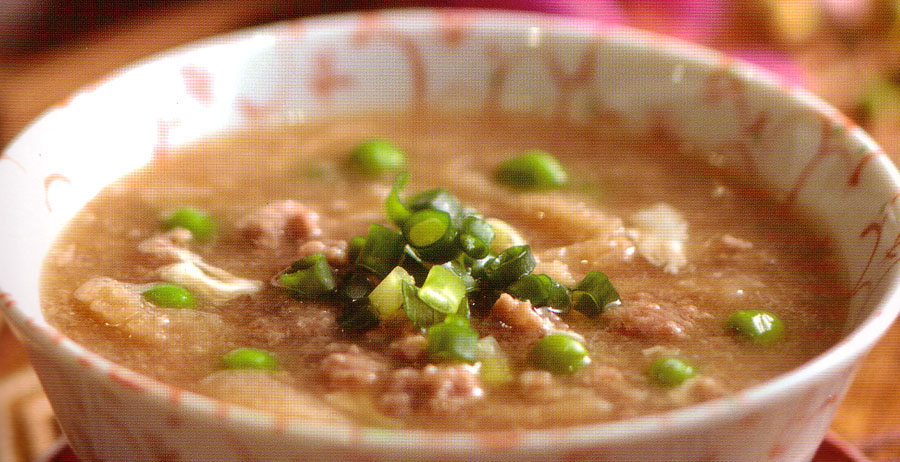 During Tang Dynasty times (618 - 907 CE) san was a poplar rice soup. It was made with small meatballs, in a sand pot, and simmered slowly. Then it was transferred to a fire pot and boiled rapidly for an additional short amount of time. Herbal soups then and since are almost always slow-cooked to extract all they can from the myriad of ingredients each one of them usually has.
During Tang Dynasty times (618 - 907 CE) san was a poplar rice soup. It was made with small meatballs, in a sand pot, and simmered slowly. Then it was transferred to a fire pot and boiled rapidly for an additional short amount of time. Herbal soups then and since are almost always slow-cooked to extract all they can from the myriad of ingredients each one of them usually has.
Traditional medical practitioners told their clients that 'soups nourish the body' so their recommended herbal soups, which they called and still call 'decoctions' suggest adding fresh Chinese olives along with chuan bei, tangerine peel, red dates, dried longan, luo han, lotus root, water cress, white fungi, dried figs, sweet and bitter almonds, ginseng, fish maw, gingko, cordyceps, and/or other wonders they tout. They select items when making a prescription for one of their patients that they believed are good to cure whatever particular condition they feel is needed to make or keep them strong and healthy, or both. They tell many of them to eat turtle soup as it is good for nourishing blood, strengthening loins, lungs, liver and kidneys, relieving internal heat, reducing toxins, or whatever else they might need.
On average, most Chinese eat soup more than five times a week, and at the end of their meals. As indicated, they do so to 'fill the cracks' the meal has not; and they eat thin soups earlier in a meal, thicker ones near its end.
Until recently, all Chinese soups were home-made. Actually, Campbell's did try to sell their condensed ones in China; tjhat was a few years ago, and they failed. Now they, Swanson, and other soup companies set up booths in grocery stores and give demonstrations on how to use their broths as a basis for Chinese soups, their other products in soups or stews, or in other creative Chinese ways. They give out many a free taste to entice folks to use these very western items in very Chinese ways.
These companies do make stronger broths to suit local tastes, they even offer a cloudy chicken, pork, and ham stock for the Chinese. However, it was not until the Japanese marketed 'ramen' or dried and what some call their 'dead' noodles, that packaged soups took off in China. They are now quite popular, but canned soups which are popular in other parts of the world, have yet to become so.
The pictures accompanying this article show soups in many kinds of containers, soups popular for breakfast, lunch, or dinner, and soups enjoyed in many different parts of China. They show Qingdao Hot and Sour Soup, Southern Lamb and Coconut Soup, West Lake Beef Soup, Shanghai Soup consumed through a straw, and more. Check the index listings on this magazine's website: www.flavorandforytune.com for many other soup recipes besides those below.
Enjoy the many different tastes from various parts of China. After you try them, do make others to suit your personal taste. Do so adding other vegetables, fruits, condiments, and/or meats. They provide greater textural and taste variety. Remember to make them thick or thin, as preferred, and do enjoy them all!
| Fujian Spinach Soup |
|---|
2 scallions, minced 3 Tablespoons crab meat, cartilage remove, then minced 6 Tablespoons minced beef or pork, or both 1 teaspoon cornstarch 1/2 pound spinach, washed then cut into thin strips 1 teaspoon vegetabel oil 2 egg yolks 1 slice fresh ginger, minced dash white ground pepper 1 Tablespoon Fujianese wine 1 teaspoon sesame oil Preparation: 1. Mix scallions wth the crab meat. 2. Mix meat with the cornstarch and make small balls, then wrap some crab meat around each ball hiding the meat in its inside. 3. Toss the spinach, oil, egg yolks, and ginger. Heat a wok or fry pan and stir-fry the spinach mixture for one minute, and remove it to a bowl or plate. 4. Bring six cups of water to the boil, reduce the heat and add the crab-meatballs, and simmer for five minutes before returning the spinach to the pot. 5. Add the ground pepper, wine, and sesame oil, simmer another minute, then serve in individual bowls or put in a pre-heated soup tureen and serve. |
| Pork Chop Soup Casserole |
|---|
1 pound Chinese pumpkin, peeled and sliced 1 Tablespoon sesame oil 1 teaspoon coarse salt 1/2 teaspoon ground black pepper 1/2 teaspoon ground white pepper 2 green apples, peeled, cored, and sliced 2 Tablespoons crushed Chinese brown slab sugar 1 teaspoon soaked dried tangerine peel, minced 5 boneless pork chops, each cut in four 1 quart chicken stock Preparation: 1. Toss the pumpkin with the sesame oil, and layer it on the bottom of a thick pot or casserole. 2. Mix the ground black and white peppers, the sliced apples, sugar, and tangerine peel, and put this mixture on the pumpkin slices. 3. Tuck the pork bones around the sides, and the pieces of pork on the top of the apple slices. 4. Pour the stock over this, bring to the boil, cover, and reduce the heat to a simmer and simmer for fifteen minutes. Remove the cover, and simmer for another hour. Remove the bones and discard, if desired, then serve. |
| Hakka Vegetarian Soup |
|---|
1 Asian eggplant, steamed for ten minutes, peel discarded, and mashed 1 tablespoon oil 1/2 green pepper, seeded and slivered, optional 1 small hot pepper, seeded and slivered 4 Chinese dried mushrooms, soaked with their stems for two hours, then both part minced 1/2 pound firm doufu, minced 2 cloves garlic, peeled and minced 1/2 teaspoon coarse salt 1/4 teaspoon ground white pepper 1 scallion, slivered 1 Tablespoon slated black beans, mashed well 1 Tablespoon minced fresh ginger 1 Tablespoon thin soy sauce 1 quart vegetable stock 1 tablespoon connstarch mixed with the same amount of cold water Preparation: 1. Mix eggplant and the oil and stir-fry one minute, then add the green pepper, if using it, and the hot pepper and the mushrooms. Stir-fry another minute. 2. Add the doufu and all the other ingredients and bring to the boil. reduce the heat and simmer for five minutes, then serve. |
| Vegetarian Hot and Sour Soup |
|---|
1/3 to 1/2 pound silken doufu, cut into thin slivers 2 Chinese black mushrooms soaked, stem removed, then slivered 1 small carrot, shredded 1/4 cup shredded bamboo shoot 2 stems cilantro, cut into small pieces 1 small stem preserved mustard green, rinsed and minced 1 Tablespoon thin soy sauce 2 Tablespoons Chinese black vinegar 1 teaspoon sugar 1 teaspoon sesame oil 1 Tablespoon cornstarch mixed with one tablespoon cornstarch 1 salted egg yolk, mashed well Preparation: 1. Mix doufu, slivered black mushrooms, shredded carrot and bamboo shoot, cilantro stems, and mustard green pieces. 2. Bring eight cups water to a boil, add the vegetable mixture, then reduce the heat and simmer for four minutes before adding soy sauce, vinegar, sugar, sesame oil, and the cornstarch mixture. Bring back to the boil, stir in the salted egg yolk, and boil for one minute, then serve. |
| Hairy Vegetable Soup |
|---|
1/2 pound pork ribs, blanched in boiling water for three minutes I hairy marrow (also known as Chinese Yam or fuzzy gourd), peeled 4 Chinese black mushrooms, soaked, their stems discarded 1/4 pound any skinless and boneless white fish 1/4 pound shrimp, peeled, their black veins discarded 2 slices fresh ginger 1 small carrot, peeled Preparation: 1. Simmer pork ribs in one quart water for one hour, discard their bones, fat, and any grizzle, and coarsely chop their meat. Reserve the meat and the cooked liquid. 2. Coarsely dice the vegetable, and mince the mushrooms, fish, shrimp, ginger, and the carrot. Add these to the meat and remaining liquid, add another quart of water to this and simmer for half an hour, then serve. |
| Many Mushroom Soup |
|---|
1 Tablespoon vegetable oil 3 slices fresh ginger, slivered 2 Tablespoons mushroom soy sauce ½ pound fresh button mushrooms, wiped clean, trimmed and sliced 1 fifteen-ounce can straw mushrooms, drained and sliced head to stem 1 pound fresh or canned oyster mushrooms, sliced 1 large fresh shiitake mushroom, stem removed, then sliced 4 dried shiitake mushrooms, soaked until soft, stems discarded, caps sliced 2 slices seaweed sheets, cut in half, then slivered 1/2 cup canned baby corn, sliced the long way 1/2 cup bamboo shoots, cut into long thin slices 1/2 cup sliced water chestnuts, cut into strips 5 cups chicken broth 1 teaspoon sesame oil 1/2 cup fresh coriander leaves and stems, chopped Preparation: 1. Heat oil and stir-fry the ginger for one minute, then add soy sauce and all the other ingredients except the fresh coriander. 2. Bring to the boil, reduce the heat, and simmer for ten minutes, then serve topped with the coriander pieces. |
| Congee of Beans, Nuts, and Grains |
|---|
1 cup dried red bans, soaked overnight, then drained and rinsed 1/2 cup raw peanuts, shells and paper exteriors removed and discarded 1/2 cup raw cashew nuts 1/2 pound pearl barley 1/2 cup glutinous rice 1/4 pound Chinese slab browbn sugar 1/4 cup goji berries 6 dired hawthorn disks 1 papaya, seeded, peeled, diced, and steamed for five minutes 1/4 cup cooked tapioca pearls, optional Preparation: 1. Bring three quarts of water to the boil, then add the soaked beans, peanuts, cashews, barley, and rice and bring to the boil, then reduce heat and simmer for one hour. 2. Add the sugar and berries and hawthorn disks and simmer another thirty minutes, stirring every ten minutes. 3. Add the papaya, and the tapioca pearls, if using them. Then serve. |

Copyright © 1994-2024 by ISACC, all rights reserved
Address
3 Jefferson Ferry Drive
S. Setauket NY 11720